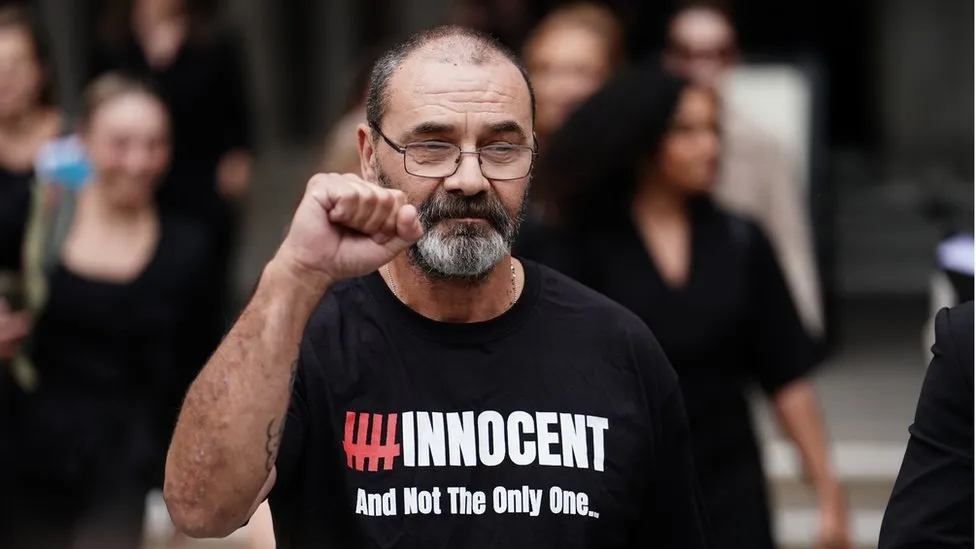Andy Malkinson's battle for justice: What happens next?
It is a month since Andy Malkinson walked out of the Court of Appeal an innocent man, having spent 17 years in jail for a rape he did not commit.

But his search for answers - and justice - is far from over. It could in fact take years.
The most important development since he was cleared happened on Thursday when Justice Secretary and Lord Chancellor Alex Chalk announced an inquiry. "There cannot be any perception that anybody is marking their own homework," he told BBC News.
It will look at the actions of the Criminal Cases Review Commission, Crown Prosecution Service and Greater Manchester Police.
Why did nobody act on DNA evidence in 2009?
The jury that convicted Andy Malkinson knew it - and the Court of Appeal last month underlined it: No forensic evidence linked Mr Malkinson to the victim or the crime scene.
But, as we reported a week ago, DNA evidence was recovered in 2007 from the victim's clothing - and it pointed to a then unknown man.
Three years before that happened, scientists discussed their findings with detectives and prosecutors and the meeting notes show its significance was understood.
So why did neither the police nor the CPS initiate further testing?
Did the prosecutors and detectives consider regular follow-up searches of the database - and if not, why not?
Why did the CCRC dismiss the DNA evidence?
After that 2009 meeting, the CPS complied with its duty to tell Mr Malkinson that new DNA had been found.
His then lawyers lobbied the Criminal Cases Review Commission to order further tests. But its case officer concluded there was nothing to be gained.
The CCRC's 2010 logs raise serious questions about its understanding of the profile.
On 14 July, its investigator wrote that there was "nothing to be gained" by retesting the DNA.
But two days later, the file shows the CCRC knew the DNA profile had not in fact been fully checked at all against the whole of the national database.
Why did GMP destroy the victim's clothes?
In 2011 Greater Manchester Police began destroying the victim's clothes. This was just eight years after the crime and before the CCRC had rejected Mr Malkinson's case.
The history of other investigations show how scientific advances can lead to astonishing results many years later.
Two of the men who fatally stabbed Stephen Lawrence in 1993 - the racist murder that changed British society - were convicted thanks to evidence recovered from clothing that had been kept safe for 18 years.
Andy Malkinson was convicted on the basis of now discredited identification evidence.
He looked nothing like the e-fit of the suspect. Two police officers who spoke to him hours after the attack saw no deep scratches on his face that the victim said she had left on the attacker.
The key factor at trial was that the victim's later mistaken identification of Mr Malkinson was supported by accounts from a couple who told police they had been out driving at 4am. They claimed to have twice seen a man who looked like Mr Malkinson near the scene of the crime.
The jury did not know this couple had serial convictions, including for dishonesty.
The female witness had four convictions for dishonesty - and she picked the wrong man out of a video line-up. She later changed her mind and chose Mr Malkinson.
The Court of Appeal heard there is no police record of why she changed her mind.
At the Court of Appeal, Mr Malkinson's team raised serious questions about the motivations of the man, Michael Seward, who has since died.
By the time of the trial, he was a known habitual drugs user with 13 convictions for 33 offences, 22 of which related to dishonesty and deception.
Between the rape in July 2003 and Mr Malkinson's conviction in February 2004, Seward was facing 14 charges.
He did not identify Mr Malkinson until six months after the attack.
Mr Malkinson's lawyers told the Court of Appeal: "Mr Seward was arrested by GMP and taken to court earlier on the same date on which he participated in the identification procedure and selected the Appellant.
"At his next court hearing days later, three charges faced by Mr Seward were withdrawn and for the remaining offences he received no term of imprisonment and just £187 in fines and costs."
The Court of Appeal said this sequence of events had been "unsatisfactory" but it did not amount to evidence that the witness had deliberately given "false evidence" for a reason which in some way implicated the police.
Why did the CCRC not investigate these witnesses?
Mr Malkinson made two failed applications to the CCRC - and on either occasion its investigations could have looked into the police files of the case and seen the criminal records for these two witnesses.
The full disclosure of facts about these two critical people only came after Mr Malkinson's team launched a series of legal actions against Greater Manchester Police to see the files.
Will Andy Malkinson be compensated for his ordeal?
There's a general scheme that pays out compensation to victims of miscarriages of justice - Justice Secretary Alex Chalk has promised it will no longer make deductions for the cost of keeping someone in prison.
But... the scheme's rules say that before he sees a penny, Mr Malkinson must end other potential compensation claims.
And this is where it starts to feel unjust, say his supporters.
If the MOJ's inquiry reaches damning conclusions, those would strengthen his case for being a victim of malicious prosecution.
That could turn into a years-long High Court battle.
The Ministry of Justice could bend the miscarriage scheme's rules and give Andy Malkinson some interim payments.
But if he accepted them, he might find himself financially disqualified from the legal aid he needs to take Greater Manchester Police to court.
This is a battle that is far from over.
-bbc







